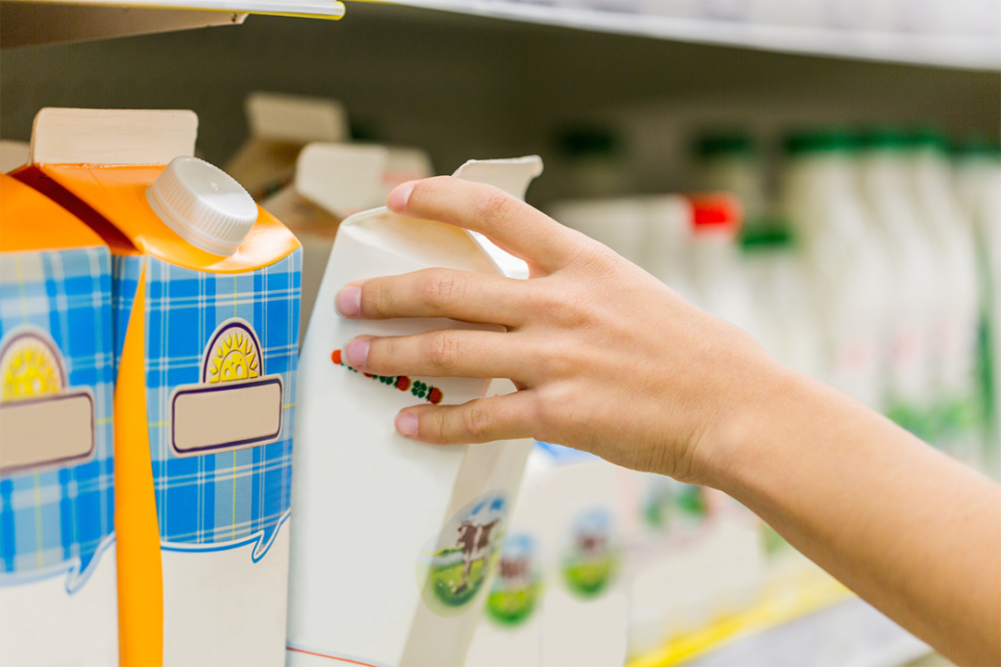KANSAS CITY — Across the supermarket, the refrigerated and frozen dairy departments face steadily rising competition from plant-based spinoffs.
Yet, over the past year, the availability of these non-dairy alternatives has not affected total dairy consumption in the United States. Dairy grocery store sales rose 14% in 2020 from 2019, to $67 billion, according to IRI, a Chicago-based market research firm. And while the 2020 numbers for overall dairy per-capita consumption are not out yet, the trend line indicates that dairy is performing well with consumers, according to the National Milk Producers Federation, Arlington, Va.
Since the US Department of Agriculture began tracking per-capita dairy consumption in the 1970s, the trend has continued upward for five straight decades, growing 21% since 1975. Increased demand for butter, cheese and ice cream this past year is expected to push per-capita US dairy consumption to its highest level ever. Even fluid milk retail sales, which had been declining significantly during the past two decades, remain above pre-pandemic levels.
“During the first seven months of 2021, dairy generated $34 billion in sales (per IRI data),” said Anne-Marie Roerink, president of 210 Analytics, San Antonio. “Compared to the massive sales peaks of 2020, this constitutes a 4.3% decline year-on-year, but an 11.1% increase compared with 2019.”
In refrigerated milk, for the 52-week period ended July 11, 2021, skim/low-fat retail sales were down 1.6% to $6.8 billion, while whole milk sales were up 2.2% to $4.9 billion, according to IRI. These figures remain higher than the 52 weeks ended July 11, 2019, which were $6.4 billion and $4.3 billion, respectively.
The category of refrigerated kefir, a probiotic cultured beverage recognized as assisting with building immunity, had been declining in the few years leading up to the pandemic. Then sales reached $96.8 million (up 5.3%) for the 52 weeks ended July 12, 2020. One year later, kefir is now a $100 million (up 3.8%) business at retail.
Refrigerated yogurt sales totaled $7.6 billion in the 52 weeks ended July 11, 2021, up 2.5% from the same period a year ago, according to IRI. Yogurt was one of the few dairy categories that did not experience double-digit growth in 2020. This relative weakness was likely due to the fact that single-serve yogurt products often are packed for lunch or consumed as an on-the-go snack. With more people staying home, yogurt sales did not boom. The opposite was true for ice cream.
“Ice cream sales set a blazing pace in 2020 and just never let up,” said Michael Dykes, president and chief executive officer, International Dairy Foods Association, Washington. “All in all, 2021 is shaping up to be one of the strongest years on record for ice cream production and sales as the US economy opens up and restaurants and foodservice compete with grocery stores for ice cream sales.”
In 2020, ice cream makers in the United States churned out just over 1 billion gallons of hard ice cream, up 6% from 2019, according to USDA data. In the first five months of 2021, hard ice cream production was running 4% ahead of 2020 levels.
Butter sales continue to be off the charts. In 2020, 78% of US households bought butter or butter blends, up from 74.5% in 2019, according to the USDA.
Natural cheese retail sales are not slowing down. The entire category was valued at the register as $15.8 billion (up 5.6%) for the 52 weeks ended July 11, 2021, according to IRI. Shredded cheese is the largest segment ($6.1 billion, up 5%); however, snacking formats are experiencing the greatest growth rates, with cubes, for example, up 12% to $148.2 million.
The International Food Information Council, Washington, conducted a survey in early April 2021 of 1,014 American adults who consume dairy at least a few times a year. The survey compared how often and why they choose dairy products and their plant-based alternatives.
Despite the ever-growing options available for dairy alternatives, dairy itself remains overwhelmingly popular among dairy consumers. According to the findings, nearly three-quarters (72%) of adults who consume dairy foods or beverages do so several times a week, compared to about one-quarter (28%) who say the same of non-dairy alternatives.
Older adults have the strongest preference for dairy compared to other age groups, with four in five of those age 55-plus saying they consume dairy foods or beverages multiple times per week, compared to two-thirds of 18- to 34-year-olds and 73% of those 35- to 54-year-olds. Conversely, only 10% of adults age 55-plus consume plant-based alternatives multiple times a week, compared to about one-third of younger people (34% of those 18 to 34 and 31% of those 35 to 54). Half of adults age 55-plus say they never consume non-dairy alternatives, standing in stark contrast to just under 8% of 18- to 34-year-olds who say the same.
When the results are broken down by specific foods, Americans prefer cheese made from dairy over plant-based versions. About three-quarters (74%) said they always choose the dairy version of cheese while 20% sometimes choose non-dairy.
Comparing other products, 68% always choose the dairy version of butter while 23% sometimes choose non-dairy; 66% always choose the dairy version of ice cream while 26% sometimes choose non-dairy; 64% always choose the dairy version of milk while 26% sometimes choose non-dairy; 62% always choose the dairy version of yogurt while 22% sometimes choose non-dairy; and 45% always choose the dairy version of yogurt-based smoothies or drinks, while 27% sometimes choose non-dairy.
Women are significantly more likely than men to sometimes choose both dairy and plant-based versions of milk (29% of women versus 23% of men), though overall product preferences are mostly similar by gender.

